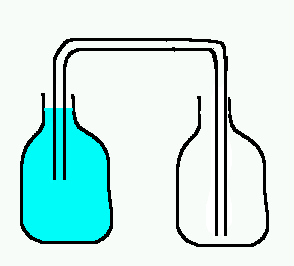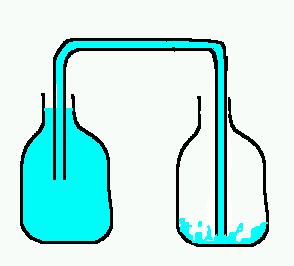 For water to move upwards,
energy must be supplied. Connecting two containers by an air-filled
tube will not cause anything to happen, since there is no source of
energy to move the water up into the tube.
For water to move upwards,
energy must be supplied. Connecting two containers by an air-filled
tube will not cause anything to happen, since there is no source of
energy to move the water up into the tube.
Usually water will not flow uphill spontaneously, and so it
seems surprising that a siphon works. However, each observation can
be explained in terms of the energy of the system.
 For water to move upwards,
energy must be supplied. Connecting two containers by an air-filled
tube will not cause anything to happen, since there is no source of
energy to move the water up into the tube.
For water to move upwards,
energy must be supplied. Connecting two containers by an air-filled
tube will not cause anything to happen, since there is no source of
energy to move the water up into the tube.
To get the siphon going, you need to add enough energy to
lift the water to fill the tube.
 When the tube is
full of water, flow can happen.
The total gravitational energy of the water in the tube doesn't
change: as water moves up on one side, water moves down on the
other. As the fluid flows, water flows from the container with the
higher surface level to the container with the lower surface level,
and the net effect on the whole system is that water has moved downhill.
The total gravitational energy of the water in the bottles is
being turned into other forms (kinetic energy of the moving water,
and eventually thermal energy of the water).
When the tube is
full of water, flow can happen.
The total gravitational energy of the water in the tube doesn't
change: as water moves up on one side, water moves down on the
other. As the fluid flows, water flows from the container with the
higher surface level to the container with the lower surface level,
and the net effect on the whole system is that water has moved downhill.
The total gravitational energy of the water in the bottles is
being turned into other forms (kinetic energy of the moving water,
and eventually thermal energy of the water).
When you increase the height difference between the two liquid levels,
the flow rate in the siphon increases, too.
On the other hand, it doesn't matter at all where the ends of the
tube are, provided that the end where the water flows into the
tube (the higher water level) is under water (perhaps you should
try doing this, to see for yourself).
A wider tube will also give a higher flow rate, and a
longer tube will have a lower flow rate.
Check the box when you are
done:
Next:Discussion of fluids